Suchen und Finden
Preface
5
Table of Contents
6
1 The State of the Art of Map-Based Mobile Services
14
1.1 Research questions and development paradigms
14
1.2 An overview of existing mobile map services
16
1.3 Adaptations and interactions
17
1.4 The usability of mobile map services
18
1.5 About the book
22
1.6 Concluding remarks
23
References
23
2 Decluttering of Icons Based on Aggregation in Mobile Maps
26
2.1 Introduction
26
2.2 Label placement in map-based applications
28
2.3 Decluttering of icons through aggregation
33
2.4 Future research directions
43
2.5 Conclusions
44
Acknowledgements
44
References
44
3 User-Centered Design of Landmark Visualizations
46
3.1 Introduction
46
3.2 Related work
47
3.3 Types of landmarks
51
3.4 Designing visualizations
53
3.5 Evaluations
60
3.6 Conclusion and outlook
67
Acknowledgements
67
References
68
4 An Incremental Strategy for Fast Transmission of Multi-Resolution Data in a Mobile System
70
4.1 Introduction
70
4.2 Some solutions for managing multi-resolution
71
data in a mobile context
71
4.3 MR data and MR data transfer models
77
4.4 Incremental strategy: conditions and interest
83
4.5 Implementation and results
86
4.6 Conclusion and outlook
90
Acknowledgements
90
References
90
5 Evaluating the Effectiveness of Non-Realistic 3D Maps for Navigation with Mobile Devices
93
5.1 Introduction
93
5.2 Computer graphics and photorealism
94
5.3 3D and cartography
97
5.4 Mobile maps
101
5.5 Expressive city models
102
5.6 Assessing the technique
104
5.7 Research observations and results
109
5.8 Research evaluation
110
5.9 Conclusion
112
Appendix A: Post-test questionnaire
112
References
115
6 Context-Aware Applications Enhanced with Commonsense Spatial Reasoning
118
6.1 Introduction
118
6.2 Knowledge-based correlation of information with spatial representation and reasoning
120
6.3 Commonsense spatial models for information correlation
124
6.4 Hybrid logics for commonsense spatial reasoning
130
6.5 A Smart home example
134
6.6 Concluding remarks
136
References
136
7 Personalising Map Feature Content for Mobile Map Users
138
7.1 Introduction
138
7.2 Related work
140
7.3 Mobile map personalisation with MAPPER
143
7.4 Designing and implementing MAPPER
149
7.5 Evaluating MAPPER efficiency
154
7.6 Conclusions and future work
156
References
156
8 A Survey of Multimodal Interfaces for Mobile Mapping Applications
159
8.1 Introduction
159
8.2 The CoMPASS system
161
8.3 Survey of existing methodologies
167
8.4 CoMPASS evaluation
172
8.5 Results
174
8.6 Discussion
177
References
178
9 User Interaction in Mobile Navigation Applications
181
9.1 Introduction
181
9.2 Cooperation and grounding
182
9.3 What is multimodality?
186
9.4 Multimodality in human-computer interaction
188
9.5 Characteristics of multimodal map navigation
191
9.6 An example: the MUMS-system
197
9.7 Discussion and future research
204
Acknowledgements
206
References
206
10 Designing Interactions for Navigation in 3D Mobile Maps
211
10.1 Introduction
211
10.2 Definitions
212
10.3 General requirements for mobile navigation interfaces
214
10.4 A model of interactive search on mobile maps
218
10.5 Designing controls
221
10.6 Designing for navigation
223
10.7 Input mechanisms
232
10.8 Navigation interface
233
10.9 Implementation notes
237
10.10 Summary
237
Acknowledgements
238
References
238
11 PDA-Assisted Indoor-Navigation with Imprecise Positioning: Results of a Desktop Usability Study
241
11.1 Introduction
241
11.2 Previous work
242
11.3 Desktop usability study
245
11.4 Results and discussion
253
11.5 Conclusions
257
Acknowledgements
258
References
258
12 Accuracy and Performance Assessment of a Window-Based Heuristic Algorithm for Real-Time Routing in Map-Based Mobile Applications
261
12.1 Introduction
261
12.2 Window-based heuristic algorithm
264
12.3 Experiments
266
12.4 Analysis of results
270
12.5 Conclusions and future research
277
References
278
13 How Mobile Maps Cooperate with Existing Navigational Infrastructure
280
13.1 Introduction
280
13.2 Background and motivation
281
13.4 Contextual design and experimental setting
286
13.5 Experimental design
289
13.6 Study results
294
13.7 Analysis and discussion
298
13.8 Conclusion
302
Acknowledgements
303
References
303
14 Geographical Data in Mobile Applications Uses beyond Map Making
306
14.1 Introduction
306
14.2 Authoring
308
14.3 Visibility
310
14.4 Filtering and highlighting
313
14.5 Photo-keying
315
14.6 3D mapping
317
14.7 Conclusion
320
Acknowledgements
321
References
321
15 Mobile Location-Based Gaming
323
15.1 Introduction
323
15.2 Review of exemplary mobile location-based games
327
15.3 Mobile location-based game components
333
15.4 Mobile location-based game tools
341
15.5 Conclusions
345
Acknowlegements
346
References
346
16 Mobile Maps and More – Extending i-Criteria Location-Based Services with Mult Decision Analysis
348
16.1 Introduction
348
16.2 Multi-criteria decision analysis in geoinformatics
349
16.3 Location-based decision support
352
16.4 Scenario of mobile decision-making in emergency response
353
16.5 Architecture of a map-based mobile decision support system
354
16.6 User interface design for a mobile decision support system for emergency response
358
16.7 Conclusions and outlook
361
Acknowledgements
362
References
362
Alle Preise verstehen sich inklusive der gesetzlichen MwSt.








